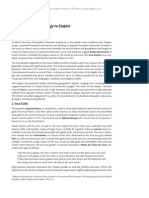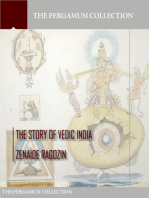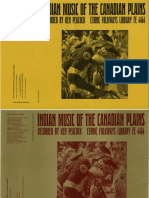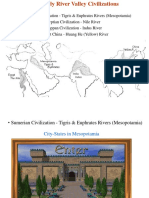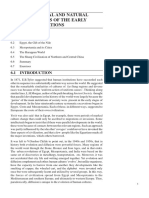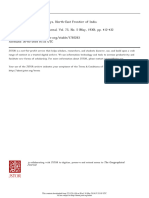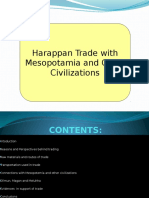-
IINTRODUCTION: INDIA AND HER ANCIENTCULTURE
TIIE LAND OT INDIA
TrB -.ie.rt civilization of India grew up in a sbarply demarcatedsub-continent bounded on the north by the world's largest mountainrange-the chain of the Himilayas, which, with its extensions toeast and lvest, divides India from the rest of Asia and the world,The barrier, however, was at no time an insuperable one, and at allperiods both settlers and traders have found their way over the highand desolate passes nto India, while Indians have carried theircommerce nd culture beyond er rontiers by tlre same oute. India'sisolation has never been complete, and the effect of the mountainwall.in developing her urrique civilization has often been over-rated.The importance of the mountains to India is not so much in theisolation which they give her, as n the fact that they are the sourceof her two great rivers. The clouds drifting northwards and west-wards n the rainy season ischarge he ast of their moisture on tl)ehigh peaks. whence, ed by ever-rnelting srrow, nnumerable streamsflow southwards, o meet n the great river systems f the Indus andthe Gangd. On their way they pass through small and fertileplateaux, such as the valleys of Kashmir and Nepdl, to debouch onthe great plain.Of the tlvo river systems, hat of the Indus, now mainly in Paki-stdn, had he earliest civilization, and gave ts name o India. * Morethan two thousand years before Christ the fertile plain of dre Panjib( " Five Rivers " ), watered by the five great tributaries of the Indus-the Jhelam, Chenib, Rivi, Beds and Satlaj-had a high culture, whichspread as far as the sea and along the westem seaboard at least asfar as Gujardt. fihe lower Indus, in the region of Pakistin Isrorvn
. The Indians knew tlis river as Sindhx, and the Persians, who found difhculty inpronouncing an initial .r, called it Hindu. l-rom Persia the lvord passed to Grcece, wircrethe whole of India becanre known bv the name ofthe western river. 'fhe ancicnt Indiansknew tlreir sutrcontil,ent as Jdtt2,udaipa (the contjnent of thejanbx tree) or Dhdrutatarpa(the I-and of the sons of Bharata, a legendary etnpcror) (p. a9of). Tlre latter nanrehas been in part revived bv the present lndia;r qovernment, With the Muslirn invasionthe Persian iame returned in theTo nn Hindustdi, and those ofits inhabitants wllo follow€dthe old religion became known as Hindus. Thc form Hindutthdn, popular in modernIndia, is an Indo-Iranian hybrid with no linguisticjustification.I

.*
, TIIE WONDER THAT WAS INDIA
as Sind, no*. passes hrough barren desert, hough this rvas once awell watered and ertile land.The basin of tl'e Indus s divided rom that of the GangE by theThar, or dcsert of Rirjastlrin, and by lo.,v hilis. The rvatershed, otlre north-rvest of Deliri, lras bccrr he sccne of many bitter battlessince at least ooo s.c. The wcstern half of the Gangi plain, rornthe region around Delhi to Patn;i, and including he Doa6, or theland between he Gangi and its great tributary river Yanrunl(formcrly spclt Jurnna, amna)r has alrvays ccn the hcart of India.I{ere, in tlre rcgion once known as .4r1'di'arta, he Jand of the Aryans,herclassical ulture vas ormed. Though generations funscientificfarming, rlcforestation, nd othcr factors have norv much educed tsfcrtility, this'ivas oncc among he most 1>rodmtive ands n the world,and t lias supported very arge population ver since t lvas broughtunder he piough. At its mouth n Bengal he Gangi f<..,rrns largedelta, which even n historical inres has gained apprcciably on thesea; here he Gangii oins the Brahmaputra, vhich lorvs romTibet byway of the Valley of Assam, he eastemnrost utpost of I{indu culture.South of the great plain is a highland zone, ising to the chain ofthe Vindhl'a rnountains. These are by no means as imprcssive asthe Hirn:ilayas, ut have ended o form a barrier betu'een he North,formerly called Hindustin, and tlre Peninsula, ften known as theDeccan nreaning sinrply "South"), a term used sometimes or thewhole peninsula, ut rnore often or its northern and central portions.Most of the Deccan s a dry and lrilly plateau, bordered on eitherside by long ranges of hills, the \['estern and Eastern Ghits. Ofthese wo ranges he western s the higher, and thercfore most ofthe rivers of the Deccan, such as the Mahenadi, the Godivari, theKistni or KyE4rI, nd the Kiviri, flow eastwards o the sea. TwoIarge rivers only, the Narmadi and he TApti, flow westwards. Neartheir mouths he Deccan ivers pass Jrrough plains which are smallerthan that of the Gangn but almost as populous. The south-easternpart of the Peninsula orms a larger plain, the Tamil countrn theculture of which lr'as once ndependent, nd s not yet completely uni-fied with that of the North. The Dravidian peoples of Southern ndiastill speak anguages n no way akin to those of the North, and areofa different ethnic character (p. e+f), though there has been muchintermixture between Northern and Southern 1pes. GeographicallyCeylon is a continuation of India, the plain of the North resemblhgthat of South India, and the mountains in the centre of the islandthe Western Ghits.From Kashmir in the North to Cape Comorin in the South thcsub<ontinent is about 2,ooo miles long, and therefore its climate
INTRODUCTTON: TNDIA AND HER ANCTENT CULTURE 3
varies considerably. The Himilayan region has cold winters, withoccasional rost and snow. In the northern plains he winter is cool,with wide variation of day and night temperature, whereas he hotseason s almost ntolerable. The temperature f the Deccan ariesless with the season, hough n the higher parts of the plateau nightsare cool in winter. The Tamil Plain is continuously hot, but itstemperature ever rises o that of the northern plains n summer.The most mportant eature of the Indian climate s the monsoon,or " the Rains . Except along he west coast and n parts of Ceylonlittle rain falls from October to May, when cultivation can onlybe carried on by carefully husbanding he rvater of rivers and streams,and aising a winter crop by irrigation. By the end of April growthhas practically ceased. The ternperature f the plains ises as highas I loo F. (4,3' C. ) or over, and an ntensely ot wind blows- Treesshed beir leaves, grass s almost completely parched, wild animalsoften die in large numbers for want of water.. Work is reducedto a minimum, ahd he world seems asleep.Then clouds appear, high in the sky; in a few days they growmore numerous and darker, rolling up in banks from the sea. Atlast, in June, he rains come in great downpouring orents, withmuch thunder and ightning.' The temperature quickly drops, andwithin a few days the world is green and smiling again. Beasts,birds and nsects eappear, he trees put on new eaves, and the earthis covered u'ith fresh grass. The torrential rains, which fall atintervals or a couple of months and then gradually dib away, maketravel and all outdoor activity difficult, and often bring epidemics n heirwake; but, despite hese hardships, o the Indian mind the coming ofthe monsoon corresponds o the coming of spring in Europe. Forthis reason hunder and ightning, in Europe generally ooked on asinauspicious, have no terrors for the Indian, but are welcome signsofthe goodness fheaven (p. aSZ).It has often been said hat the scale ofnatural phenomena n India,and her total dependence n the monsoon, have helped to form thecharacter fher peoples. Even today major disasters, uch as lood,famine and plague, are hard to check, and n older times their controlwas almost impossible. Many other ancient civilizations, such asthose of the Greeks, Romans and Chinese, had o contend with hardwinters, which encouragecl turdiness and resource. India, on theother hand, was blessed y a bounteous Nature, who demanded itdeof man in return for sustenance, ut in her terrible anger could notbe appeased by *y human effort. Hence, it has been suggested,the Indian character has tended to fatalism and guietism, acceptingfortune and nrisfortune alike without complaint.
V
TIIE WONDI]R TIIAT WAS INDIA
How far this judgement s a fair one is very dubious. Thoughan element f quietism certainly existed n the ancient ndian attitudcto life, as t does n India today, t was never approved by moralists.The great achievements f ancient ndia and Ceylon-their immenseirrigation works and splendid emples, and the long campaigns oftheir armies-do not suggest a devital;zed people. If the climatehad any effect on the ndian character t was, we believe, o develop alove of ease and comfort, an addictibn o the simple pleasures ndluxuries so reely given by Nature-a tendencv o u'hich he impulseto selfdenial and asceticism n the one hand, and occasional trenuouseffort on the other, were natural eactions.
THE DISCOVN,RY OF ANCIENT IND A
The ancient civilization of India differs from those of Egypt,Mesopotamia nd Greece, n that its traditions have been preservedwithout a break down to the present day. Until the advent of theanchreologist, he peasant fEgypt or Iraq had no knowledge of theculture of his forefathers, and it is doubtful whether his Greekcounterpart had any but the vaguest deas about the glory of Peri-clean Athens. In each ase lrere had been an almostcomplete reakwith the past. On the other hand, the earliest Europeans o visitIndia found a culture fully conscious f its own antiquity-a culturewhich indeed exaggerated hat antiquitl, and claimed not to havefundarnentally hanged or many thousands of years. To this daylegends known to the humblest ndian recall the names of shadowychieftains who lived nearly a thousand ears before Christ, and theorthodox brihmap in his daily worship epeats ymns composed venearlier. India and China have, n fact, lre oldest continuous ulturaltraditions n the world.Until the last half of the r8th century Europeans made no realattempt to study India's ancient past, and her early history wasknown only from brief passages n the ll'orks of Greek and Latinauthors. A few devoted missionaries n the Peninsula ained a deepunderstanding of conternporary ndian life, and a brilliant mastery ofthe vernaculars, but they made no real attempt to understand thehistorical background f the culture ofthe people among whom theyworked.- They accepted hat culture at its face value, as very ancientand unchanging, rrd their only studies of India's past were in thenature of speculations inking the Indians with the descendants fNoah and he vanished empires of the Bible.Meanwhile a few Jesuits succeeded n mastering Sanskrit, thcclassical anguage of India. One of them, Father Hanxleden, whoworked in Kerala from 1699 to llss, compiled the first Sanskrit
INTRODUCTIONI INDIA AND IiER .\NCIENT CULTURE
grarnmar n a Europern or)gue, wlrit:h emained n manuscript, ut*as used by his successors. Another, 'ather Coeurdoux, n l?6?,u as probably he first student o recognize he kinslrip f Sanslirit ndtlre anguages f Europe, nd suggested hat the brahnrans f InCianere descended ronr one of the sons of Japlret, wlrose brotlrersrnigrated o the West. Yet the Jesuits, or all their studies, ainedno real understanding f India's past: the foundations f Indologyu ere aid independently, n another part of India, and by other hands.In thc I'ear l?sj one of tlre most brilliart rrcn of tlre l8tlrcentury, Sir William Jones ( t746-94), calne to Calcutta as ajudge of the Supreme Court, under the governor-generalship fWarren {astings, who himself ad deep yrnpatlr_y vith both
Nfuslirnand Hindu culturc. Jones vas a linguistic genius, who had alreadylearnt all the more rnportant anguages f Europe as well as Hebrew,Arabic, Persian and Turkish, and had even obtairred smattering ofChinese with the aid of the very inadequate material which wasavailable t the time. Before conring o India lte had ecoguized herelationship of European anguages o Persian, and had rejected heorthodox view of the I 8th century, hat all these ongues were derivedfrorn Hebrew, whiclr had been
arbled at the Tower of Babel. In placeof this dognra ones uggested hat Persian nd he European anguageswere derived rom a common ancestor which was not Hebrew.Of the little band of Englishmen who administered engal or theHonourable ast ndia Company nly one, Charles Wilhins (174.9-I896), had managed o Iearn Sanskrit. With the aid of Wilkinsand riendly Bengali pandits Jones began o learn the anguage. Onthe first day of r784 the Asiatic Society f Bengal was ounded, nJones' nitiative, and with Jones imself as president. In the ournalof this society, siatic Researches,the irst real steps n revealing ndia'spast were taKen. In November 1784 he first direct ranslation fa Sanskrit u'ork into English, Wilkins's Bhagaoad, ild', was conr-pleted. This Wilkins follorved n l?87 with a translation of theHitopade{a. In 1?89 Jones ransiated Kalidasa's Sakuntald, whicb,went into five English editions n less than twenty years; this hefollowed by translations of the Gita Gouinda tZsz), and the law-book of Manu (pubiished postirumously n t?94, under the titleInstitutes of Hindoo In ). Several less important translationsappeared n successive ssues fr4slatic Researches.Jones nd Wilkins u'ere ruly the fathers of Indology. They werefollor,r'ed n Calcutta by Henry Colebrooke tZes-rsSZ) and HoraceHayman Wilson (tzss-tsoo). To the works of these pioneersmust be added hat of the Frenchman Anquetil-Duperron, a Persianscholar who, in l?86, published a translatiorr f tour Upanigads rom
6 THE WoNDER THAT wAs TNDIA
a lTth{entury Persian version-the translation of the whole manu-script, containing 5O Upanigads, ppearing n 180I.Interest n Sanskrit iterature began o grow in Europe as a resultof these rans-lations. n 1795 he government of the French Republicfounded he cole des Langues Orie-ntales ivantes, and n Paris Alex-ander lamilton (r762-ts94), one of the earliest menrbers f theAsiatic Society of Bengal, held prisoner on parole in France at the endof the Peace f Amiens n 18o3, became he first person o teach San-skrit in Europe. It'n'as rom Hamilton thatFriedriclrSchlegel, he irstGerman Sanskritist, earnt the language. The first university chairof Sanskrit was founded at the Collbge de France n 1814., nd heldby L6onard de Ch6zy, while rom l8l8 onwards he arger Germanuniversities set up professorships. Sanskrit u,as first taught inEngland in l8o5 at the training college of the East India Companyat Hertford. The earliest English chair was the Boden Professor-ship at Oxford, first filled n 1892, when it was conferred upon H. H.Wilson, who had been an mportant member of the Asiatic Society ofBengal. Chairs were afterwards ounded at London, Canrbridge ndEdinburgh, and at several ther universities of Europe and America.In 18t6, Franz Bopp (tZst-tsoz;, a Bavarian, on the basis ofthe hints of Sir Wiiliam Jones, succeeded n very tentatively recon-structing he common ancestor fSanskrit and he classical anguagesof Europe, and comparative philology became an independentscience. In 182I, the French Soci6t6 Asiatique was founded nParis, followed two years later by the Royal Asiatic Society inL,ondon. From these beginnings he work of the editing and studyof ancient Indiah literature went on apace hroughout the lgthcentury. Probably he greatest achievement f Indological scholar-ship in lgth-century Europg was the enormous Sanskrit-Germandictionary generally known as the St. Petersburg Lexicon, producedby the German scholars Otto Bdhtlingk and Rudolf Roth, and pub.lished in parts by the Russian mperial Academy of Sciences romt852 to t875. England's greatest contributions o Sanskrit studieswere the splendid edition of the f;g Yeda, and the great series ofauthoritative arurotated ranslations, Sacred Bools of the East, Boththese u'orks were edited by the great German Sanskritist FriedrichMax.Miiller (tszs-rsoo), who spent most of his working life asProfessor f Comparative Philology at Oxford.Meanwhile the study of aricient ndian culture was proceeding nanother direction. The first work of the Asiatic Society of Bengalhad been almost entirely iterary and inguistic, and most of the tgth:century ndologists were primarily scholars n the classical radition,working on written records. Early in the lgth century, however,
INTRODUCTION: INDIA AND HER ANCIENT CULTURE
the Bengal Society began o turn some of its attention to the materialremains of India's past, as the East India Company's surveyorgbrought back o Calcutta many reports oftemples, caves and shrines,together with early coins and copies of inscriptions n long-deadscripts. By working backtvards rom the current scripts he olderones were gradually deciphered, until in l8g7 a gifted amateur,James Prinsep, an official of the Calcutta Mint and Secretary of theAsiatic Society of Bengal, nterpreted or the first time the earliestBrihmi script and was able to read the edicts of the great emperorA6oka. Among Prinsep's colleagues n the work of decipherment.tilas a young oflicer of the Royal Engineers, Alexander Cururinghamthe father of Indian archeology. From his arrival in India in1891 Cunningham devoted every minute he could spare romhis nrilitary duties to the study of the material remains ofancient ndia, until, in 1862, he Indian government established hepost of Archaological Surveyor, o which he was appointed. Untilhis retirement n 1885 he devoted himself o the unravelling ofIndia's past with complete single-heartedness. Though he madeno startling discoveries, nd though his technique was, by modernarchaological standards, crude and primitive, there is no doubtthat, after Sir William Jones, Indology owes more to GeneralSir Alexander Cunningham han to any other worker in the field.Cunningham was assisted by several other pioneers, and thoughat the end of the rgth century the activities of the ArchreologicalSurvey almost ceased, rving to niggardly government grants, byt90o many ancient buildings had been surveyed, and many nscriptionsread and translated.It was only in the 2oth century hat archeological xcavation n alarge scale began n India. Thanks to the personal nterest of theViceroy, Lord Curzon, n tgol the Archaological Survey was r€-formed and enlarged, and a young archeologist, John (later SirJohn) Ilarshall, appointed as Director General. F<.rr a countryof the size of India the Archeological Department was stiillamentably srirall and poor, but Marshall rvas able to employ anumber ofexpert assistants, nd tad unds or excavation on a scalemore extensive han anything previously attempted. For the firsttime traces of the ancient cities of India began o come to light-archeology, as distinct from the surveying and conservation ofancient monuments-had egun n real earnest. The greatest riumphof the Archaeological Survey of India under Sir Jolrn Marshall'sdirectorship was undoubtedly he discovery of the Indus civilization.The first relics of India's oldest cities were noticed by Cunningham,who found strange unidentified seals in the neighbourhood of



